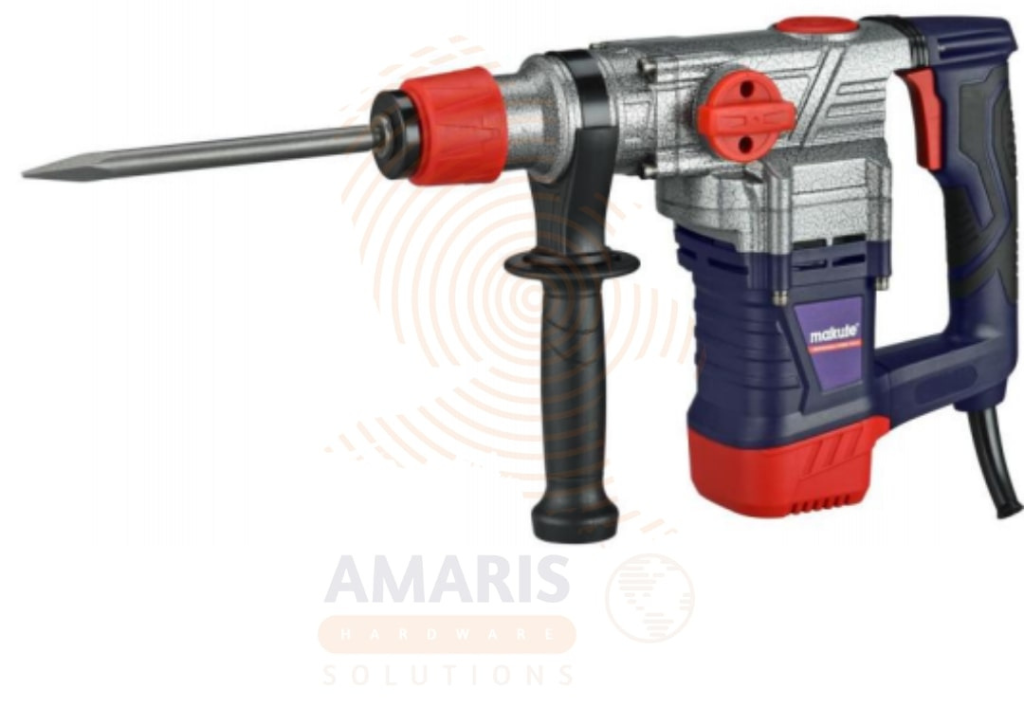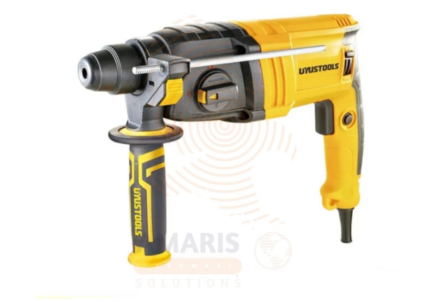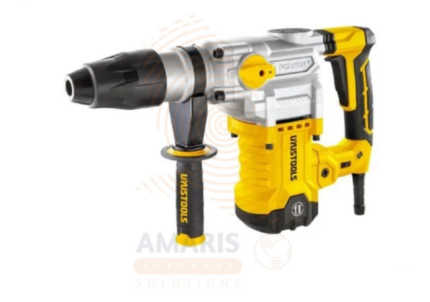Rotary Hammer Drill
WhatsApp Order
A rotary hammer drill is a powerful and specialized tool designed for drilling into tough materials such as concrete, masonry, or stone. It combines the functions of a regular drill with a hammering action, where the drill bit not only rotates but also moves forward and backward in a hammer-like motion. This dual-action mechanism enables the rotary hammer drill to break through hard surfaces more efficiently than a standard drill, making it an essential tool for tasks like drilling holes in concrete for anchors, bolts, or other construction purposes.
Categories: Drills & Drivers, POWER TOOLS, Rotary Tools
Tags: concrete drill, construction tool, hammer drill, heavy-duty drill, masonry tool, power tool, rotary hammer drill
Description
Table of Contents
ToggleRotary Hammer Drill
Uses
-
Drilling into Concrete and Masonry:
-
One of the primary purposes of a rotary hammer drill is to drill holes in tough materials like concrete, masonry, and stone. This is particularly useful for installing anchors, bolts, or other fasteners in construction projects.
-
-
Demolition Work:
-
The hammering action of the rotary hammer drill makes it effective for light to medium-duty demolition tasks. It can be used to break up and remove concrete, tiles, or other hard surfaces.
-
-
Chiseling:
-
Some rotary hammer drills come with chiseling features, allowing them to be used for tasks like chipping away excess material, shaping surfaces, or removing tiles.
-
-
Installing Electrical Boxes and Pipes:
-
When working on electrical installations or plumbing projects, a rotary hammer drill can be used to create holes in walls or floors for running wires, cables, or pipes.
-
-
Concrete and Masonry Repair:
-
For repair and maintenance work, a rotary hammer drill is essential for drilling holes to inject epoxy or install concrete anchors. It can also be used to remove damaged sections for patching or replacement.
-
-
Landscaping:
-
In landscaping projects, a rotary hammer drill can be employed to create holes for fence posts, outdoor structures, or other installations in hard surfaces like concrete or compacted soil.
-
-
Tile Removal:
-
The hammering action of the rotary hammer drill makes it effective for breaking up and removing tiles from walls or floors during renovation projects.
-
-
Installing Drywall Anchors:
-
When attaching items to walls made of concrete or masonry, a rotary hammer drill is useful for creating the necessary holes for anchors.
-
-
Foundation Work:
-
In construction, rotary hammer drills are often used for drilling into concrete foundations for various purposes, such as installing reinforcing bars or anchors.
-
-
General Construction and Carpentry:
-
Rotary hammer drills find application in various general construction and carpentry tasks where drilling into hard materials is required.
-
SAFETY HANDLING PRECAUTIONS
Safety Precautions
-
Read the User Manual:
-
Familiarize yourself with the user manual provided by the manufacturer. It contains essential information about the tool's operation, safety instructions, and maintenance guidelines.
-
-
Wear Personal Protective Equipment (PPE):
-
Always wear appropriate personal protective equipment, including safety glasses or goggles, hearing protection, dust mask, and work gloves. This gear helps protect against potential hazards such as flying debris, dust, and noise.
-
-
Inspect the Tool:
-
Before use, inspect the rotary hammer drill for any damage or defects. Check the power cord, plug, and other components to ensure they are in good condition. Do not use a damaged tool.
-
-
Select the Right Tool and Accessories:
-
Use the appropriate rotary hammer drill and accessories for the task at hand. Ensure that the drill bit or attachment is securely fitted and in good condition.
-
-
Secure Workpiece:
-
Secure the workpiece firmly in place using clamps or other suitable methods. This prevents movement during drilling and reduces the risk of accidents.
-
-
Use the Proper Drill Bits:
-
Use drill bits designed for rotary hammer drills and suitable for the material you are working on. Using the wrong type of bit can result in damage to the tool or injury.
-
-
Maintain a Firm Stance:
-
Maintain a stable and balanced stance while operating the rotary hammer drill. Keep your feet shoulder-width apart to ensure better control and stability.
-
-
Control the Tool Properly:
-
Grip the tool with both hands, placing one hand on the handle and the other on the auxiliary handle if provided. Keep a firm grip and control the tool to prevent it from slipping or jerking unexpectedly.
-
-
Start Gradually:
-
When starting the rotary hammer drill, begin with a slow speed and gradually increase it as needed. Sudden and excessive force can lead to loss of control.
-
-
Keep Hands Clear:
-
Keep hands and body parts away from the drill bit while the tool is in operation. Avoid reaching over the drill bit or placing hands near moving parts.
-
-
Use Dust Collection Systems:
-
If drilling generates dust, use a dust collection system or wear a dust mask to protect against inhalation of airborne particles.
-
-
Disconnect Power when Changing Bits:
-
Before changing drill bits or accessories, disconnect the power source. This prevents accidental starts and ensures safety during maintenance.
-
-
Turn Off Power when Not in Use:
-
Always turn off the rotary hammer drill and disconnect it from the power source when not in use. This prevents accidental starts and unauthorized use.
-
-
Work in Well-Lit Areas:
-
Ensure that the work area is well-lit, allowing for better visibility and reducing the risk of accidents.
-
-
Follow Electrical Safety Precautions:
-
If using a corded rotary hammer drill, inspect the power cord for damage, and use a grounded electrical outlet. Avoid using damaged extension cords, and keep cords away from the drill bit.
-
Related products
Big Battery Pro
A " Big Battery Pro" typically refers to a rechargeable lithium-ion battery with a nominal voltage of 20 volts. The nominal voltage represents the average voltage output over the majority of the battery's discharge cycle. It's important to note that the actual voltage during use may fluctuate within a specified range.
These batteries are commonly used to power various devices, including power tools, garden equipment, and other portable electronic devices. The "20V" designation is a standardized measure indicating the electrical potential of the battery, providing a general indication of its power output.
Keep in mind that when considering a 20V battery, it's essential to verify compatibility with the specific device or tool it is intended for. Additionally, different manufacturers may have variations in the actual voltage, capacity, and features of their 20V battery products. Checking the product documentation or contacting the manufacturer for detailed specifications is recommended for accurate information.
Cement Blender
A cement blender is a mechanical device designed for the purpose of mixing and blending various components of cementitious materials, such as cement, sand, and water, to create a homogenous mixture. This blended mixture is commonly used in construction and building projects, particularly for applications like concrete production. The blender typically features a rotating drum or container that facilitates the thorough mixing of the ingredients, ensuring a consistent and uniform composition for the construction materials.
Chuck Die Grinder
A Chuck Die Grinder is a handheld power tool equipped with a collet or chuck that holds a rotary burr or abrasive head. This tool is commonly used for precision grinding, polishing, and shaping of metal, wood, plastic, and other materials. Chuck Die Grinders are versatile and compact, allowing for intricate and detailed work in various applications, including metalworking, woodworking, and fabrication. They are widely employed in industries such as machining, automotive, and aerospace, as well as by hobbyists and craftsmen for tasks requiring fine control and high-speed material removal.
Circular Saw
A circular saw is a power tool equipped with a rotating circular blade, typically with teeth along its edge, designed for cutting various materials such as wood, plastic, metal, or masonry. It is commonly used in carpentry, construction, and other applications to make straight or beveled cuts with precision and efficiency. The circular saw is versatile and can be handheld or mounted on a table or other stationary surface, depending on the specific model and intended use.
Cordless Angle Grinder
A cordless angle grinder is a handheld power tool designed for cutting, grinding, and polishing materials, typically metal or masonry. Unlike traditional angle grinders that are powered by electrical cords, cordless angle grinders are equipped with rechargeable batteries, providing greater mobility and flexibility in various work environments. These tools often feature a rotating disc or wheel that can be fitted with different abrasive attachments, allowing users to perform a variety of tasks such as cutting metal, smoothing welds, or removing rust and paint. Cordless angle grinders are widely used in construction, metalworking, and fabrication applications.
Countersink Drill Set
A countersink drill set typically refers to a collection of six tools designed for countersinking operations in woodworking or metalworking. Each set usually includes six individual countersink drills with varying sizes or angles. Countersinking is a process that involves creating a conical hole in a material, allowing the head of a screw or bolt to sit flush with or below the surface. These drill sets are essential for achieving a professional finish in various applications where a smooth and even surface is desired, such as in carpentry, metal fabrication, or DIY projects.
Electric Router
PRODUCT DESCRIPTION
An electric router is a power tool used in woodworking and carpentry for hollowing out an area or creating a specific profile on the edge of a material, typically wood. It operates by spinning a cutting tool or bit at high speeds, allowing for precise and controlled removal of material. Electric routers are versatile tools and can be equipped with various bits to perform tasks such as shaping, grooving, trimming, and forming decorative edges. They are widely employed in both professional and DIY settings for tasks that require accurate and intricate detailing in woodworking projects.
Glass Drill Set Hexagonal Handle
PRODUCT DESCRIPTION
A glass drill set with hexagonal handles typically refers to a collection of five drill bits specifically designed for drilling holes in glass surfaces. The term "hexagonal handle" indicates that the shank of each drill bit has a hexagonal (six-sided) shape, which can provide a better grip and prevent slipping when used with a compatible drill. These drill bits are specifically crafted for working with glass materials, offering precision and minimizing the risk of cracking or damaging the glass during the drilling process. The set may include different-sized bits to accommodate various hole diameters.


 Acrylic Sealants
Acrylic Sealants Construction Adhesives
Construction Adhesives Double-Sided Tape
Double-Sided Tape Duct Tape
Duct Tape Electrical Tape
Electrical Tape Epoxy & Resins
Epoxy & Resins Masking Tape
Masking Tape
 Automotive Wrenches & Socket Sets
Automotive Wrenches & Socket Sets Battery Chargers & Jump Starters
Battery Chargers & Jump Starters Car Jacks & Stands
Car Jacks & Stands Car Wash & Detailing Products
Car Wash & Detailing Products Diagnostic Tools
Diagnostic Tools Tire Inflators
Tire Inflators Vehicle Lighting
Vehicle Lighting Oil & Lubricants
Oil & Lubricants
 Adhesives & Sealants
Adhesives & Sealants Bricks & Blocks
Bricks & Blocks Cement & Concrete
Cement & Concrete Drywall & Plaster
Drywall & Plaster Flooring (Tiles, Wood, Laminate)
Flooring (Tiles, Wood, Laminate) Lumber & Plywood
Lumber & Plywood Paints, Primers & Coatings
Paints, Primers & Coatings Insulation Materials
Insulation Materials Roofing Materials
Roofing Materials
 Circuit Breakers
Circuit Breakers Electrical Cables & Wires
Electrical Cables & Wires Switches & Sockets
Switches & Sockets Fuses & Relays
Fuses & Relays Connectors & Terminals
Connectors & Terminals Electrical Boxes & Panels
Electrical Boxes & Panels Conduit & Fittings
Conduit & Fittings Lighting Fixtures & Bulbs
Lighting Fixtures & Bulbs Extension Cords & Power Strips
Extension Cords & Power Strips
 Anchors
Anchors Bolts
Bolts Clips & Clamps
Clips & Clamps Screws
Screws Nuts
Nuts Washers
Washers Rivets
Rivets Nails
Nails Threaded Rods
Threaded Rods
 Hammers
Hammers Measuring Tools (Tapes, Levels, Calipers)
Measuring Tools (Tapes, Levels, Calipers) Screwdrivers
Screwdrivers Pliers & Cutters
Pliers & Cutters Saws & Blades
Saws & Blades Chisels & Punches
Chisels & Punches Allen Keys & Hex Keys
Allen Keys & Hex Keys Ratchets & Socket Sets
Ratchets & Socket Sets Wrenches & Spanners
Wrenches & Spanners
 Power Tool Accessories (Blades, Bits, Discs)
Power Tool Accessories (Blades, Bits, Discs) Rotary Tools
Rotary Tools Saws (Circular, Jigsaw, Reciprocating)
Saws (Circular, Jigsaw, Reciprocating) Drills & Drivers
Drills & Drivers Grinders & Sanders
Grinders & Sanders Heat Guns
Heat Guns Nail Guns
Nail Guns Impact Wrenches
Impact Wrenches Batteries & Chargers
Batteries & Chargers
 Pipes & Fittings (PVC, Copper, PEX)
Pipes & Fittings (PVC, Copper, PEX) Plumbing Tools
Plumbing Tools Pumps & Motors
Pumps & Motors Sealants & Adhesives for Plumbing
Sealants & Adhesives for Plumbing Valves & Taps
Valves & Taps Water Heaters
Water Heaters Drainage Systems
Drainage Systems Faucets & Fixtures
Faucets & Fixtures Hoses & Tubing
Hoses & Tubing
 Hinges & Latches
Hinges & Latches Hooks & Brackets
Hooks & Brackets Window Hardware
Window Hardware Chains & Cables
Chains & Cables Casters & Wheels
Casters & Wheels Shelving & Storage Systems
Shelving & Storage Systems Door Handles & Locks
Door Handles & Locks Drawer Slides & Cabinet Hardware
Drawer Slides & Cabinet Hardware
 Personal Protective Equipment (PPE)
Personal Protective Equipment (PPE) Respirators & Masks
Respirators & Masks Safety Glasses
Safety Glasses Safes
Safes Security Cameras
Security Cameras Gloves
Gloves Helmets
Helmets Ear Protection
Ear Protection Fire Safety Equipment
Fire Safety Equipment Locks & Padlocks
Locks & Padlocks Motion Sensors & Alarms
Motion Sensors & Alarms
 Garden Fencing
Garden Fencing Garden Furniture Hardware
Garden Furniture Hardware Lawn Mowers
Lawn Mowers Trimmers & Edgers
Trimmers & Edgers Shovels & Spades
Shovels & Spades Rakes & Hoes
Rakes & Hoes Pruning Shears & Loppers
Pruning Shears & Loppers Watering Systems (Hoses, Sprinklers, Nozzles)
Watering Systems (Hoses, Sprinklers, Nozzles)
 Interior Paints
Interior Paints Paint Brushes & Rollers
Paint Brushes & Rollers Paint Strippers & Thinners
Paint Strippers & Thinners Paint Trays & Accessories
Paint Trays & Accessories Exterior Paints
Exterior Paints Spray Paints
Spray Paints Primers & Undercoats
Primers & Undercoats Varnishes & Stains
Varnishes & Stains
 Gaskets & Seals
Gaskets & Seals Hydraulic Fittings
Hydraulic Fittings Industrial Fasteners
Industrial Fasteners Industrial Hoses
Industrial Hoses Lubricants & Greases
Lubricants & Greases Metal Sheets & Bars
Metal Sheets & Bars Bearings & Bushings
Bearings & Bushings Belts & Pulleys
Belts & Pulleys
 HVAC Filters
HVAC Filters Insulation for HVAC
Insulation for HVAC Air Conditioners
Air Conditioners Refrigerants
Refrigerants Ventilation Ducts & Fittings
Ventilation Ducts & Fittings Thermostats & Controllers
Thermostats & Controllers Fans & Blowers
Fans & Blowers
 Pegboards & Hooks
Pegboards & Hooks Shelving Units
Shelving Units Storage Bins & Containers
Storage Bins & Containers Toolboxes & Tool Chests
Toolboxes & Tool Chests Workbenches
Workbenches Drawer Organizers
Drawer Organizers Labeling Supplies
Labeling Supplies
 Welding Accessories (Clamps, Brushes)
Welding Accessories (Clamps, Brushes) Welding Electrodes & Rods
Welding Electrodes & Rods Welding Helmets & Gloves
Welding Helmets & Gloves Welding Machines
Welding Machines Soldering Irons & Stations
Soldering Irons & Stations Flux & Solder Wire
Flux & Solder Wire
 Generator Accessories
Generator Accessories Inverters
Inverters Portable Generators
Portable Generators Power Inverters
Power Inverters Transfer Switches
Transfer Switches Diesel & Gasoline Generators
Diesel & Gasoline Generators
 Transport Equipment: Carts, Dollies, and Hand Trucks
Transport Equipment: Carts, Dollies, and Hand Trucks Storage Solutions: Pallets, Racks, and Containers
Storage Solutions: Pallets, Racks, and Containers Lifting Equipment: Hoists, Cranes, and Jacks
Lifting Equipment: Hoists, Cranes, and Jacks Conveyors and Accessories: Belts and Rollers
Conveyors and Accessories: Belts and Rollers






